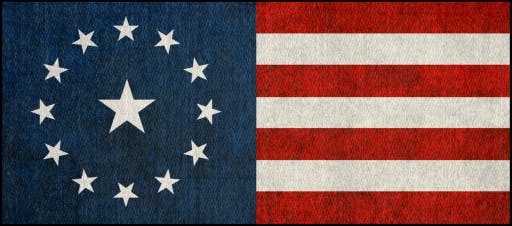1. What were Vice-Admiralty Courts used for in English Law?
a) Resolving disputes between states
b) Handling maritime causes and prize-related matters
c) Regulating foreign trade
d) Enforcing criminal laws at sea
Answer: b
2. How did the United States' relationship with the English Crown change?
a) The United States gained full independence from British rule.
b) The United States became a British territory.
c) The United States entered into a commercial joint venture with the English Crown.
d) The United States formed a military alliance with England.
Answer: c
3. What was the real purpose of the 14th Amendment in the United States?
a) To abolish slavery
b) To establish a new currency
c) To provide suffrage to women
d) To bring individuals back under British rule
Answer: d
4. Which event is associated with the "Emergency Banking Act of 1933"?
a) The establishment of the Federal Reserve System
b) The return to the gold standard
c) The confiscation of gold from citizens
d) The creation of a new currency backed by gold
Answer: c
5. How did the Emergency Banking Act of 1933 impact the currency?
a) It introduced a new gold-backed currency.
b) It changed the currency to Federal Reserve Bank Notes.
c) It replaced the currency with foreign exchange.
d) It led to the introduction of local emergency currencies.
Answer: b
6. What was the significance of House Joint Resolution 192?
a) It established the gold standard.
b) It confirmed the UNITED STATES' bankruptcy.
c) It granted emergency powers to the President.
d) It defined the role of Federal Reserve Agents.
Answer: b
7. What backed the new currency introduced after the Emergency Banking Act of 1933?
a) Gold and silver certificates
b) Gold bars and bullion
c) Direct obligations of the UNITED STATES
d) Foreign exchange reserves
Answer: c
8. What did the Emergency Banking Act of 1933 define as "circulating notes"?
a) Notes issued by state banks
b) Federal Reserve Bank Notes
c) Gold and silver coins
d) Foreign currency
Answer: b
9. What was the main reason for the banking holiday initiated in 1933?
a) The government's desire to control the currency
b) A shortage of gold reserves in the banks
c) The need to transition to a new currency system
d) The public's demand for more paper money
Answer: b
10. What was the primary collateral backing the Federal Reserve Bank Notes?
a) Gold and silver bullion
b) Federal Reserve member banks loans
c) Direct obligations of foreign countries
d) Real estate properties
Answer: b
11. What significant change occurred in the United States' currency system after the Emergency Banking Act of 1933?
a) Gold became the sole currency standard.
b) The currency was backed by foreign exchange.
c) The real money transitioned from a gold standard to a debt-based standard currency (Federal Reserve Bank Notes "paper monopoly money").
d) The currency was replaced with a barter system.
Answer: c
12. What was the impact of House Joint Resolution 192 on the gold clause?
a) It reaffirmed the gold clause as a fundamental right.
b) It abolished the gold clause in all obligations.
c) It reinforced the United States' commitment to gold-backed currency.
d) It introduced a new clause related to silver in obligations.
Answer: b
NOTE: The United States gold clause refers to a provision that was included in many contracts, especially financial and debt-related contracts, issued by the U.S. government prior to 1933. This clause stipulated that the debtor had to repay the debt in gold equivalent to the value of the currency at the time the contract was entered into.
During this period, the U.S. was on a gold standard, where the value of the U.S. dollar was tied to a specific amount of gold. This meant that the dollar was redeemable for a fixed amount of gold, and the gold clause in contracts ensured that the value of the debt would be preserved in terms of gold, regardless of any fluctuations in the value of the currency.
13. What term is used to describe the principle by which the government is guided in managing public affairs?
a) Public law
b) Public policy
c) Monetary standard
d) Constitutional guidance
Answer: b
14. How did the Emergency Banking Act impact the status of gold ownership by individuals?
a) It allowed individuals to freely own and trade gold.
b) It required individuals to exchange their gold for bank notes. (People faced prison time if they refused to turn in their gold)
c) It prohibited individuals from owning gold altogether.
d) It introduced a tax on gold ownership.
Answer: b
15. What was the primary reason for the Federal Reserve Bankers to advocate for the transition away from a gold-backed currency?
a) To establish a more stable monetary system
b) To gain greater control over the nation's wealth
c) To reduce the value of gold globally
d) To align with international banking regulations
Answer: b
16. How did the Banking Holiday of 1933 affect the public's access to their deposits?
a) It allowed unrestricted access to deposits.
b) It temporarily suspended banking transactions.
c) It mandated the conversion of deposits to gold.
d) It led to the seizure of all bank assets.
Answer: b
17. What was the primary intention behind the issuance of "clearing house certificates"?
a) To promote international trade
b) To create local emergency currencies
c) To standardize banking operations
d) To replace Federal Reserve Bank Notes
Answer: b
NOTE: In 1933, the establishment of the Reconstruction Finance Corporation (RFC) was a part of the Emergency Banking Act of 1933. As a part of the RFC's efforts to stabilize the "banking system" and inject liquidity into the economy, it introduced a program involving "Clearing House Certificates."
Clearing House Certificates were a type of "emergency currency" issued by the RFC through member banks' clearinghouses. These certificates were intended to alleviate the liquidity crisis that many banks were facing at the time. The process worked as follows:
A. Banks that were experiencing a shortage of currency or liquidity would deposit their eligible collateral (such as government bonds) with their regional clearinghouse.
B. The clearinghouse would then issue Clearing House Certificates to the banks, which were essentially a form of scrip or promissory notes. These certificates were backed by the deposited collateral and were considered a form of emergency currency.
C. Member banks could use these certificates for various transactions and payments, thereby providing them with a temporary means of conducting business and meeting their obligations.
18. What did the United States government deposit in exchange for "circulating notes" according to the Emergency Banking Act?
a) Direct obligations of foreign governments
b) Gold and silver coins
c) Bank loans and notes
d) Treasury notes and obligations
Answer: d
19. How did the Emergency Banking Act impact the role of Federal Reserve Agents?
a) It made them responsible for currency printing.
b) It granted them emergency powers in wartime.
c) It allowed them to act as agents of the Treasury.
d) It gave them authority over foreign exchange.
Answer: c
NOTE: The Emergency Banking Act of 1933 allowed Federal Reserve Agents (a private corporation) the ability to act as agents of the Treasury (A governement entity).
20. Which provision of the Trading with the Enemy Act became crucial during the banking crisis?
a) Foreign exchange regulations
b) Export and import restrictions
c) Regulation of maritime trade
d) Control over gold ownership
Answer: d
21. What happened to gold held by the public during the banking holiday?
a) It was confiscated by the government
b) It was converted into Federal Reserve Notes
c) It was used to back new bank deposits
d) It was stored in the Federal Reserve banks
Answer: a
22. How did the government respond to the public demand for gold during the Great Depression?
a) By issuing more gold certificates
b) By backing the currency with foreign gold reserves
c) By imposing fines and prison sentences for not turning in gold
d) By encouraging citizens to keep their gold
Answer: c
23. Why did President Franklin Delano Roosevelt issue an Executive Order based on the Trading with the Enemy Act of 1917?
a) To declare a national holiday
b) To confiscate private gold holdings
c) To regulate foreign exchange transactions
d) To stabilize the banking system
Answer: b
24. What was the primary reason for the banking holiday declared by President Roosevelt?
a) To investigate the Federal Reserve System
b) To protect the banks from public demands
c) To introduce a new form of emergency currency
d) To encourage people to deposit their gold
Answer: b
25. How did House Joint Resolution 192 impact the American citizens' ability to demand gold payment?
a) It allowed citizens to demand gold payments from banks
b) It made it illegal for citizens to demand gold payments
c) It granted citizens the right to convert currency to gold
d) It increased the value of gold for citizens
Answer: b
26. How did House Joint Resolution 192 affect the currency's connection to gold?
a) It restored the gold standard and linked the currency to gold
b) It completely severed the currency's link to gold
c) It introduced a dual currency system with gold and paper money
d) It allowed citizens to choose between gold and paper money
Answer: b
27. Why did the Federal Reserve Bank Notes replace gold as backing for the currency?
a) To stabilize the value of the currency
b) To increase government revenue
c) To reduce dependence on foreign gold reserves
d) To create a debt-based currency
Answer: d
NOTE: It's important to know and understand the difference between Gold-Backed Currency (GBC) and Debt-Cased Currency (DCC)
Gold-backed currency, also known as the gold standard, is a monetary system in which the value of a country's currency is directly linked to a specific quantity of gold. Under this system, each unit of currency, such as a dollar or a pound, is exchangeable for a fixed amount of gold. This link to a tangible and limited resource like gold is intended to provide stability and prevent excessive inflation.
Debt-based currency, also known as fiat currency, is the most common monetary system in use today. In this system, a country's currency has value simply because the government declares it as legal tender. There is no physical backed asset (like gold) backing the currency; its only value is based on people's trust in the issuing government and the stability of the economy.
28. What was the impact of the Trading with the Enemy Act on American citizens?
a) It granted citizens more financial freedom
b) It protected citizens' gold holdings
c) It made citizens liable for foreign exchange violations
d) It restricted citizens' access to gold and foreign exchange
Answer: d
29. What was the significance of Proclamation 2039 and 2040 issued by President Roosevelt?
a) They established a new national currency
b) They allowed citizens to keep their gold
c) They declared a state of emergency due to foreign exchange issues
d) They gave the President emergency powers to regulate currency
Answer: d
30. What does the term "hard assets" refer to?
a) Physical properties owned by the government
b) Assets backed by foreign currencies
c) Tangible resources such as gold and silver
d) Investments in foreign banks
Answer: c
-
View All: https://americanpatriotsocial.com/strawman/gku.html
-
NOTE: If you would like to comment or join the active discussion on this post please visit the link below to join 1350 group on American Patriot Social.



